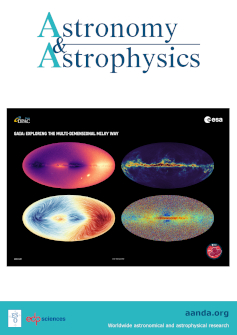The SRG/eROSITA all-sky survey
IF 5.4
2区 物理与天体物理
Q1 ASTRONOMY & ASTROPHYSICS
引用次数: 0
Abstract
The evolution of the cluster mass function traces the growth of linear density perturbations, providing valuable insights into the growth of structures, the nature of dark matter, and the cosmological parameters governing the Universe. The primary science goal of eROSITA, on board the Spectrum Roentgen Gamma (SRG) mission, is to constrain cosmology through the evolution of the cluster mass function. In this paper, we present a set of cosmological constraints obtained from 5259 clusters of galaxies detected over an area of 12791 deg2 in the western Galactic hemisphere of eROSITA’s first All-Sky Survey (eRASS1). The common footprint region (4968 deg2) between the eROSITA Survey and Dark Energy Survey (DES), the Kilo-Degree Survey (KiDS), and the Hyper Supreme Camera (HSC) survey is used for calibration of the scaling between X-ray count rate of the clusters and their total mass through measurements of their weak gravitational lensing signal. The eRASS1 cluster abundances constrain the ΛCDM parameters, namely, the energy density of the total matter to Ωm = 0.29−0.02+0.01 and the normalization of the density fluctuations to σ8 = 0.88 ± 0.02, and their combination yields S8 = σ8(Ωm/0.3)0.5 = 0.86 ± 0.01. These results are consistent and achieve at a similar precision with state-of-the-art cosmic microwave background (CMB) measurements. Furthermore, the eRASS1 cosmological experiment places a most stringent upper limit on the summed masses of left-handed light neutrinos to ∑ mv < 0.43 eV (95% confidence interval) from cluster number counts alone. By combining eRASS1 cluster abundance measurements with CMB- and ground-based neutrino oscillation experiments, we measured the summed neutrino masses to be ∑ mv = 0.09−0.02+0.04 eV or ∑ mv = 0.12−0.02+0.03 eV, assuming a normal or inverted mass hierarchy scenario for neutrino eigenstates. The eRASS1 cluster abundances significantly improve the constraints on the dark energy equation of state parameter to w = −1.12 ± 0.12. When ∑ mv and w are left free, we find consistent results with the concordance ΛCDM cosmology. Our results from the first All-Sky Survey improve the cosmological constraints by over a factor of 5 to 9 over the previous cluster surveys, establishing cluster abundance measurements for precision cosmology and setting the stage for deeper eROSITA All-Sky Surveys, as well as for future cluster abundance experiments.SRG/eROSITA 全天空勘测
星团质量函数的演变追踪线性密度扰动的增长,为了解结构的增长、暗物质的性质和宇宙学参数提供了宝贵的信息。光谱伦琴伽马(SRG)任务上的 eROSITA 的主要科学目标是通过星团质量函数的演变来约束宇宙学。在本文中,我们介绍了在 eROSITA 第一次全天空巡天(eRASS1)的银河系西半球 12791 度 2 的区域内探测到的 5259 个星系团所获得的一组宇宙学约束。eROSITA 巡天和暗能量巡天(DES)、千度巡天(KiDS)以及超至尊照相机(HSC)巡天之间的共同足迹区域(4968 deg2)被用于通过测量星团的弱引力透镜信号来校准星团的 X 射线计数率与其总质量之间的比例关系。eRASS1星团丰度约束了ΛCDM参数,即总物质的能量密度为Ωm = 0.29-0.02+0.01,密度波动的归一化为σ8 = 0.88 ± 0.02,两者结合得到S8 = σ8(Ωm/0.3)0.5 = 0.86 ± 0.01。这些结果与最先进的宇宙微波背景(CMB)测量结果是一致的,并达到了相似的精度。此外,eRASS1 宇宙学实验仅从星团数量计数上就将左手轻中微子的总和质量最严格地限制在∑ mv 0.43 eV(95%置信区间)。通过将eRASS1星团丰度测量与CMB和地基中微子振荡实验相结合,我们测得中微子质量总和为∑ mv = 0.09-0.02+0.04 eV或∑ mv = 0.12-0.02+0.03 eV,假定中微子特征状态的质量等级为正常或倒置。eRASS1 星团丰度极大地改进了对暗能量状态方程参数的约束,达到 w = -1.12 ± 0.12。当∑ mv和w不受限制时,我们发现与一致的ΛCDM宇宙学结果是一致的。我们第一次全天空巡天的结果比以前的星团巡天的宇宙学约束提高了5到9倍,为精确宇宙学建立了星团丰度测量方法,为更深入的eROSITA全天空巡天以及未来的星团丰度实验奠定了基础。
本文章由计算机程序翻译,如有差异,请以英文原文为准。
求助全文
约1分钟内获得全文
求助全文
来源期刊

Astronomy & Astrophysics
地学天文-天文与天体物理
CiteScore
10.20
自引率
27.70%
发文量
2105
审稿时长
1-2 weeks
期刊介绍:
Astronomy & Astrophysics is an international Journal that publishes papers on all aspects of astronomy and astrophysics (theoretical, observational, and instrumental) independently of the techniques used to obtain the results.
 求助内容:
求助内容: 应助结果提醒方式:
应助结果提醒方式:


